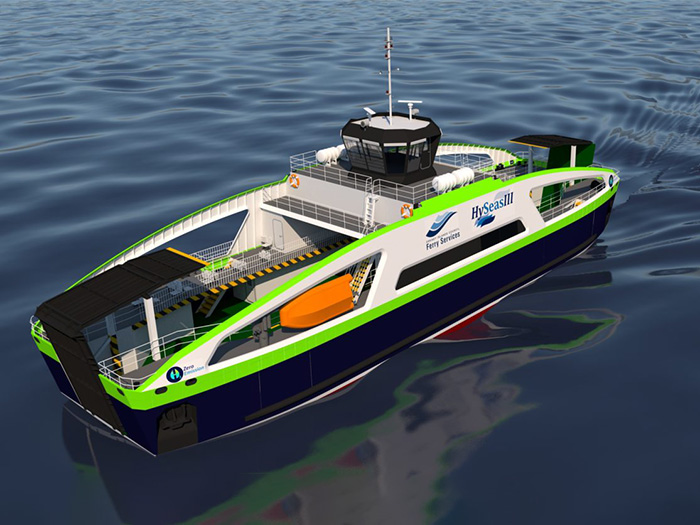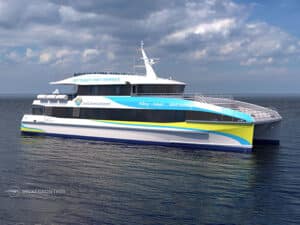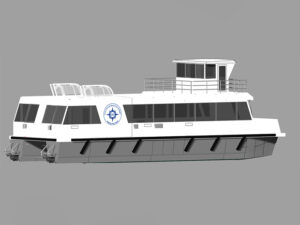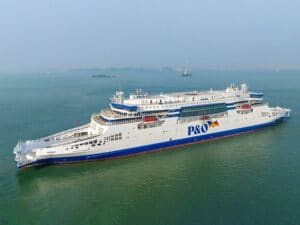
Plans for seagoing hydrogen fuel cell ferry move ahead
Written by Nick Blenkey
Image: AqualisBraemar LOC Group
The Scottish-led Hyseas III project, which aims to build Europe’s first sea-going hydrogen fuel cell powered ferry, reports significant progress.The AqualisBraemar LOC Group has completed designs which show what the vessel, which will store energy from renewable sources, is likely to look like. As a double-ended sea-going passenger and car ferry, it will have a capacity for 120 passengers and 16 cars or two trucks. It has been designed to operate on the route between Kirkwall and Shapinsay in the Orkney Islands, where hydrogen fuel is generated through wind power. It will also be capable of operating at other ports where hydrogen could become available in the future.
Meantime, progress is being made on string testing to demonstrate the complete fuel cell/battery/multidrive/propulsion. The full size string test mirrors the load requirements of the new ferry on the Shapinsay to Kirkwall route, and will confirm power and fuel capacity requirements. The results will provide valuable information, which will be fed back to the team to be incorporated into the design.
The components of the string test have been assembled on site at PSW Power’s facility at Ågotnes in Norway and consortium partner Kongsberg Maritime has started carrying out a comprehensive range of commissioning, safety and verification tests, assisted by fuel cell supplier Ballard Power Systems. As the fuel cells themselves are being run, the string test site is getting regular deliveries of compressed hydrogen at 200 bar from Linde Gas. This testing includes the various components that make up the safety system, including hydrogen gas detectors, alarms and emergency shutdown systems.
“As with any project, the tests have highlighted issues that need to be addressed, and various troubleshooting activities are also underway,” says the latest update from the project. “Once all these are completed satisfactorily, a full suite of system validation tests will be carried out, simulating how the system would be used in an actual ship, However even at this stage of testing, the team has accumulated extensive experience of integrating fuel cells and batteries into a marine propulsion system, and the work will help lay the foundation for safe, reliable and optimized use of hydrogen fuel cells on ships.”
Partners in the EU-funded project are:
- Vessel design and development: Caledonian Maritime Assets Limited (Scotland, U.K.)
- Fuel cell power systems: Ballard Power Systems Europe A/S (Hobro, Denmark)
- Vessel systems integrator: Kongsberg Maritime AS (Kongsberg, Norway)
- Fueling Infrastructure: McPhy Energy SA (France)
- Vessel and ports owner/operator: Orkney Island Council (Orkney Islands, U.K.)
- Lifecycle and socio-economic analysis: DLR Institute of Networked Energy Systems (Oldenburg, Germany)
- Dissemination and communications: Interferry (Sweden), Arcsilea Ltd (London, U.K.)
- The team is coordinated by the University of St.Andrews (St. Andrews, Scotland).
The next stage of the project will see the consortium seek feasibility approval in principle of the designs from classification society DNV.
The design will be complete in March 2022, at which point CMAL will seek funding partners to take the approved design to the procurement stage, which will lead on to the eventual tendering and construction of the vessel.
“We know that maritime transport remains the U.K.’s largest emitter of greenhouse gases, and our Hyseas III project will pave the way for the first seagoing vessel using purely renewable energy,” said John Salton, Fleet Manager and Projects Director at CMAL. “Seeing the concept designs brings the project to life. The vessel design is broadly based on our larger loch class vessels, which are double-ended. Once the designs are approved, we will move to the next stage of the project, which will see the build of the engine to be used in feasibility studies.”




